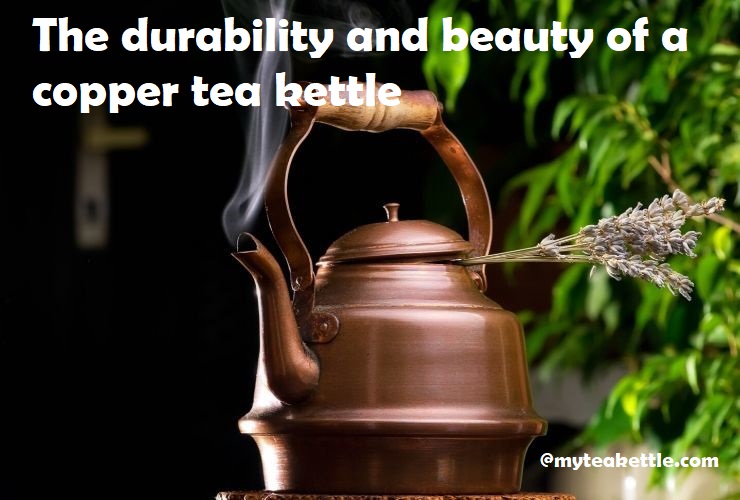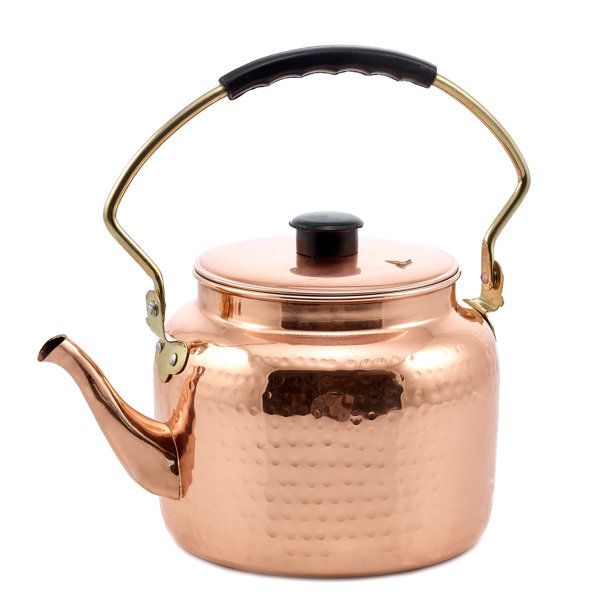Have you ever wanted to purchase a unique and practical tea kettle? Do you desire something that will add a touch of elegance to your kitchen? Look no further than the stunning copper tea kettle.
This guide provides all the information you need on why a copper tea kettle is the perfect choice; durable, eye-catching, and highly efficient. You won’t regret adding this timeless piece to your collection.
An insurance of Utmost Durability and Aesthetics. Prolonged tea-brewing with copper tea kettles is making a return among coffee and tea connoisseurs alike who want exquisite flavor, advanced aesthetics, and maximum heat efficiency.
This article seeks to define the benefits of copper tea kettles, answer some commonly asked questions about copper kettles, and discuss how to take care of it for optimal performance. With this guide in hand, you can confidently purchase the perfect copper kettle for your needs and experience unparalleled durability with the most beautiful brewing equipment under your roof.
Definition of a copper tea kettle
A copper tea kettle is a traditional metal kitchen pot or pan used for boiling water. Copper tea kettles are usually made of metal alloys that have been treated to improve their durability, such as a tin lining or brass or bronze alloying. More recently, some stainless steel versions of these tea kettles are emerging in different shapes and sizes.
A copper tea kettle adds to the attractiveness of any home décor; Its bright, metallic color reflects light while matching almost any design style. It’s also very durable, lasting many years if cared for properly. Copper has been used in the kitchen for centuries, making it an ideal material for practically anything you’re looking to cook up!
Despite their beauty and durability, copper tea kettles can be harder to use than other materials like stainless steel or glass as they require more maintenance and special care. This guide will help you understand how to use and clean your copper tea kettle efficiently while taking advantage of its unique properties and beauty!
History of Copper Tea Kettles
There is a long history of using copper for the manufacture and use of tea kettles. These tea kettles can be found from Europe all the way to Pakistan, India, China and Japan. In Europe, copper tea kettles have been made since at least the early 1800s. They were very popular throughout Europe until the invention of stainless steel in the early 1920s. Before this, copper was the predominant material used for making tea kettles and other vessels for boiling water for making tea or coffee.
The use of copper cauldrons was first documented in India by Dioscorides in 50 AD. Copper vessels have traditionally been regarded as auspicious vessels that bring health, wealth and prosperity to their owners. In modern times, demand for copper tea kettles has grown steadily due to its aesthetic value, longevity and health benefits; copper has long been believed by many cultures to be beneficial as an anti-microbial surface which resists harmful bacteria growth within the kettle.
Origin of copper tea kettles
Copper tea kettles have been in use since the 16th century, with some of the earliest versions originating in China and Japan. Since then, many cultures around the globe have embraced kettle brewing as part of their heritage and history. The beautiful designs and durability of a copper tea kettle have made them favorites for both traditional and modern brewers alike.
Additionally, copper is highly conductive, meaning that it can quickly heat up quickly to create a desirable temperature for infusing loose-leaf or bagged tea. Copper has also been shown to interact beneficially with alkaloids found in certain teas such as Darjeeling or Assam to highlight its naturally sweet taste characters like honey or malt. For these reasons and more, copper is a popular choice for many teapots used by today’s enthusiasts.
III. Advantages of Copper Tea Kettles
Copper is an attractive, functional choice for traditional tea kettles. This durable metal can conduct heat quickly and evenly, resulting in a well-brewed pot of tea in no time. Not only does it perform well, but its aesthetic qualities lend a certain charm to any kitchen.
Copper is also a soft metal that can be easily molded into intricate shapes, so you can find elaborate designs with swirls, floral shapes, and other whimsical touches.
Durability
Copper is one of the most durable materials for tea kettles, providing a lifetime of service. Copper tea kettles will not corrode or discolor over time and can withstand high levels of heat. This makes them ideal for boiling water quickly, unlike other metals which can easily become warped or pitted when exposed to high temperatures.
Copper tea kettles also require less maintenance than other materials, such as stainless steel, because they do not need to be wiped down regularly with special cleaning solutions. When cared for correctly and properly heated, copper will last a lifetime; however, it can eventually start to turn green due to oxidation—but this does not affect the durability of your kettle.
Heat conductivity
Copper is an excellent conductor of heat, with a thermal conductivity rate more than three times higher than stainless steel. This means that copper tea kettles can heat up quickly and evenly, making sure your tea gets heated to the right temperature and ready to enjoy much faster.
Copper kettles also have greater control over their heat, so if you are aiming for a specific temperature you can more easily regulate it on a copper kettle than on other types. This makes copper particularly useful for delicate teas, like green teas or whites that need to steep at a lower temperature.
Copper is also much less likely than other types of materials to scorch or burn tea when it’s boiled in the kettle.
Caring for Your Copper Tea Kettle
It’s important to take care of your copper tea kettle to ensure it lasts for years. Copper is a soft and pliable metal, so the finish may scratch over time if not properly taken care of. Here are some things you should do to ensure your tea kettle looks great and remains functional:
- Clean your tea kettle with a mild detergent and warm water at least once a week. Use nonabrasive cloths or sponges when cleaning, as abrasive materials can damage the finish.
- Rinse off any remaining soap after cleaning; soap residue can cause rust spots over time.
- Make sure that your copper tea kettle is completely dry before storing it away; this will help prevent stains and rust spots.
- For duller finish, use some copper cleaner or polish to restore its original shine.
- Apply a thin layer of food-grade mineral oil occasionally to keep the copper from having a dull appearance again in the future.
- Never place copper items in direct contact with salt water as it can easily corrode them.
Cleaning
Purchasing a copper tea kettle is an investment in long-term durability and beauty, but with its extreme shine and intrinsic properties, it needs proper cleansing to prevent tarnish or discoloration. To maintain your copper tea kettle and keep it looking as good as new, you should use it regularly and clean it properly. The following are some tips for its care and upkeep.
To remove discoloration from the surface of your copper tea kettle, make a paste of white vinegar combined with flour that is thick enough to spread easily on the surface. Rub the paste gently onto the copper with a soft cloth until the discoloration has been removed. To restore an even sheen to your tea kettle, use fine steel wool pad or special polishing compound for copper. After rubbing to polish your kettle, rinse it with lukewarm water and dry thoroughly.
You can also take preventive measures by regularly wiping down your copper tea kettle with lemon juice or chamois cloth after every use and ensuring that you never leave any liquid inside overnight; allowing liquid to diffuse in with the metal can reduce its longevity. For deeper cleaning once every few months or when necessary, fill up your copper tea kettle halfway up with boiling water mixed with white vinegar and let sit for an hour before adding additional cooking soda mixed in water until the rust deposits have been cleared then rinse thoroughly before drying completely. Taking necessary precautions will help keep you proud of beautiful piece of craftsmanship for years to come!
Polishing
Polishing your copper tea kettle restores it to its original shine and helps extend its lifetime. Depending on the nature of your tarnish, polishing could be an easy process or require some patience. The most important thing is to choose the right polishing formula for copper, as extra-strength formulas can cause damage to copper.
To polish a copper tea kettle, start by removing any existing stains with a soft cloth and a small amount of white vinegar. Then apply a gentle polish or liquid designed exclusively for use on copper. Then rinse off with clean water and buff it dry with another soft cloth. Avoid rubbing too hard as this can cause further damage to the teapot’s surface. If you are unable to remove more persistent spots, try creating a paste from baking soda and baking powder and mix it with lemon juice until it forms a thick paste before gently buffing the tea kettle again.
Once complete, leave the pot to dry naturally before using – don’t forget to add one teaspoon of salt for every cup of water in order to prevent discoloration in future!
Conclusion
A copper tea kettle is a classic accessory to any kitchen. Its unique look, strength and durability makes it an ideal alternative to any other type of tea kettle ever made. Not only does it offer superior heating capability, it also has been found to possess some natural antimicrobial qualities not found in other metals that can help keep your water clean and free from potentially harmful bacteria.
Starting from the handle design, to the spout, base and sides, all of these elements come together to give you an excellent piece of cookware that will never let you down. Not only will it last for generations when properly maintained but its beauty and presence make it a great addition to your kitchen decor as well. When taking into account all of these aspects, there is no doubt that a high quality copper tea kettle can provide fantastic features for years to come.
FAQ’s
How long does a copper kettle last?
Copper kettles can last for several years, even decades, with proper care and maintenance.
Why are copper kettles better?
Copper kettles are better because they conduct heat more efficiently and evenly than other materials, which can lead to faster boiling times and better tasting tea or coffee.
What properties does a copper kettle have?
Copper kettles have excellent heat conductivity, are durable, and have natural antimicrobial properties that can help keep them clean.
What material is best for tea kettles?
Stainless steel and copper are both good materials for tea kettles, as they are durable and conduct heat well.
Is it safe to drink water boiled in a copper kettle?
Yes, it is safe to drink water boiled in a copper kettle as long as the kettle is properly maintained and cleaned.
Is copper a good material for a kettle?
Yes, copper is a good material for a kettle because of its excellent heat conductivity and durability.
How do you maintain a copper kettle?
To maintain a copper kettle, it should be cleaned regularly with a solution of vinegar and salt or lemon juice and baking soda, and dried thoroughly after use.
Is it safe to use copper tea kettles?
Yes, it is safe to use copper tea kettles as long as they are properly maintained and cleaned.
How do I keep my copper kettle shiny?
To keep a copper kettle shiny, it should be polished regularly with a solution of lemon juice and baking soda or a commercial copper cleaner.
Are copper kettles better than stainless steel?
Copper kettles are better than stainless steel in terms of heat conductivity, but stainless steel is more durable and easier to maintain. Ultimately, the choice between the two materials comes down to personal preference.
See Also-
- Best tea kettle
- Best kettle for pour over coffee
- Best smart kettle
- Best pour over kettle
- Best whistling tea kettle

